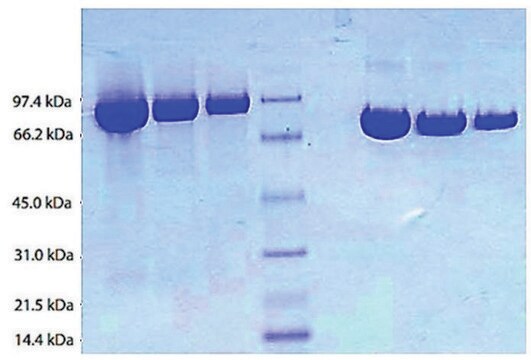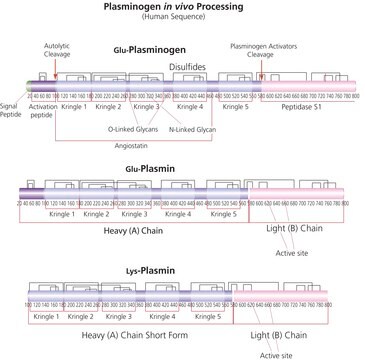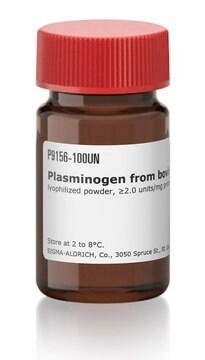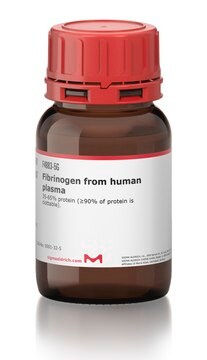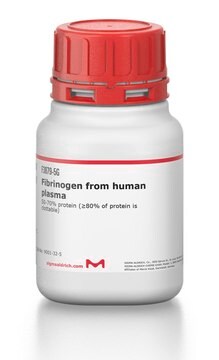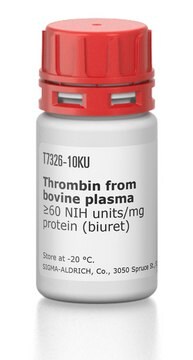10874477001
Roche
Plasminogen
from human serum
Sinónimos:
plasminogen
Iniciar sesiónpara Ver la Fijación de precios por contrato y de la organización
About This Item
Código UNSPSC:
12352204
Productos recomendados
origen biológico
human serum
Nivel de calidad
Formulario
lyophilized
actividad específica
~11 units/mg protein (activated with streptokinase at 37 °C and pH 7.4 with Chromozym PL as the substrate.)
mol peso
90-94 kDa
envase
pkg of 20 U
fabricante / nombre comercial
Roche
técnicas
activity assay: suitable
aplicaciones
life science and biopharma
Condiciones de envío
wet ice
Descripción general
Plasminogen is a profibrinolysin from human serum. Plasminogen, the proenzyme of the fibrinolytically active enzyme plasmin, is a single chain glycoprotein. Various isoelectric forms exist and can be separated by means of isoelectric focusing (IEF). The lyophilizate is stabilized with bovine serum albumin (BSA).
Aplicación
Plasminogen is used for the determination of the activity of plasminogen activators. The enzyme is a substrate for tissue plasminogen activator (t-PA) in the t-PA test and a reference substance for t-PA therapy. It is used as the in-process control in the production of t-PA.
Características y beneficios
Contents
Lyophilizate, stabilized with bovine serum albumin.
Lyophilizate, stabilized with bovine serum albumin.
Calidad
Contaminants: <0.05% plasmin; the preparation does not contain 6-aminohexanoic acid
Secuencia
Native plasminogen (glu-plasminogen) has a N-terminal glutamic acid group. Partial plasma proteolysis gives rise to a molecule with N-terminal lysine (lys-plasminogen). Cleavage with elastase results in val-plasminogen. The complete amino acid sequence contains 790 amino acids. Roche Applied Science supplies glu-plasminogen.
Nota de preparación
Stabilizers: stabilized with BSA
Working solution: Solvent is recommended in 20 mM sodium phosphate buffer, pH 7.5, 100 mM NaCl.
Storage conditions (working solution): -15 to -25 °C
A solution in 20 mM sodium phosphate buffer, pH ca. 7.5, 100 mM NaCl is stable for several months without loss of activity when stored at -15 to -25 °C.
Note:
Plasminogen is susceptible to autolysis, which may result in activation. Contact with the skin or other contamination (e.g., by microorganisms), is therefore to be avoided.
Working solution: Solvent is recommended in 20 mM sodium phosphate buffer, pH 7.5, 100 mM NaCl.
Storage conditions (working solution): -15 to -25 °C
A solution in 20 mM sodium phosphate buffer, pH ca. 7.5, 100 mM NaCl is stable for several months without loss of activity when stored at -15 to -25 °C.
Note:
Plasminogen is susceptible to autolysis, which may result in activation. Contact with the skin or other contamination (e.g., by microorganisms), is therefore to be avoided.
Almacenamiento y estabilidad
Store at 2 to 8 °C. (Store dry!)
Otras notas
For life science research only. Not for use in diagnostic procedures.
Palabra de señalización
Warning
Frases de peligro
Consejos de prudencia
Clasificaciones de peligro
STOT RE 2
Código de clase de almacenamiento
11 - Combustible Solids
Clase de riesgo para el agua (WGK)
WGK 2
Punto de inflamabilidad (°F)
does not flash
Punto de inflamabilidad (°C)
does not flash
Elija entre una de las versiones más recientes:
¿Ya tiene este producto?
Encuentre la documentación para los productos que ha comprado recientemente en la Biblioteca de documentos.
Los clientes también vieron
Andrea Schweinitz et al.
The Journal of biological chemistry, 279(32), 33613-33622 (2004-05-20)
The serine protease urokinase-type plasminogen activator (uPA) interacts with a specific receptor (uPAR) on the surface of various cell types, including tumor cells, and plays a crucial role in pericellular proteolysis. High levels of uPA and uPAR often correlate with
Claudine Ferland et al.
Journal of immunology (Baltimore, Md. : 1950), 173(7), 4417-4424 (2004-09-24)
Increased eosinophil counts are a major feature of asthmatic airways. Eosinophil recruitment requires migration through epithelium and tissue extracellular matrix by activation of proteases. We assessed the capacity of IL-16, a CD4(+) cell chemotactic factor, to induce migration of eosinophils
H Roger Lijnen
Biochemistry. Biokhimiia, 67(1), 92-98 (2002-02-14)
Several molecular interactions between the matrix metalloproteinase (MMP) and the plasminogen/plasmin (fibrinolytic) system may affect cellular fibrinolysis. MMP-3 (stromelysin-1) specifically hydrolyzes urokinase (u-PA), yielding a 17 kD NH2-terminal fragment containing the functionally intact receptor (u-PAR)-binding sequence and a 32 kD
A Krüger et al.
Cancer gene therapy, 7(2), 292-299 (2000-04-19)
The serine protease urokinase-type plasminogen activator, uPA, when bound to its specific receptor, uPAR (CD87), plays a significant role in tumor cell invasion and metastasis. In breast cancer, enhanced uPA antigen in the primary tumor is correlated with poor prognosis
Global Trade Item Number
| Número de referencia del producto (SKU) | GTIN |
|---|---|
| 10874477001 | 4061838250568 |
Nuestro equipo de científicos tiene experiencia en todas las áreas de investigación: Ciencias de la vida, Ciencia de los materiales, Síntesis química, Cromatografía, Analítica y muchas otras.
Póngase en contacto con el Servicio técnico